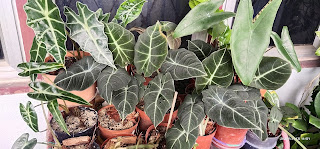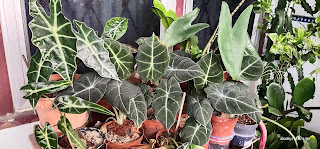INTRODUCTION:
Very much earlier I had an Alocasia collection which have been decimated due to heavy spider-mite infection, I tried few methods using various pesticides, neem soap and neem oil, and constantly washing the leaves and plants hoping to eradicate the infection - each time I do so, the plant succumb to stress and goes into dormancy - I did end up losing few species over time, and with my overzealousness - even trimmed and pruned the damaged leaves. This only caused more stress and the poor plant eventually died.
After few months of rest (just to make sure - there is no residue of the spider-mites that might come back and infect this second collection in rebound) I started slow with just the Black Velvet Alocasia. I believe these are produced using tissue culture which came in a bulk and with a huge price drop. Usually these plant cost RM50 when it trending, very much earlier for RM30 for a normal price. But these tissue culture plants cost almost half of that (RM17.00)
However the rest of the collection retained to the original prices ranging from RM30-RM50. This was my deciding factor whether I would want to start all over again knowing the nature of these sensitive plants of which they cannot tolerate any mistakes - overwatering and wrong medium. Let alone, spidermites that can be devastating when left unchecked.
By then, I have figure out the solution where locating the best planting position for them, they are exposed to daily watering where the get their foliage wet but not the medium - this ensures to discourage the mites from infesting again but to make absolutely sure - I do apply miticide which I found the best one so far that eradicate them in one application without my worry on the re-infection.
Hence, armed with this second experience and knowledge, here are the list of the things that I had listed below for future reference for Plant Care and Maintenance:
LIGHT:
One of the Main factor is Lighting - they require good indirect bright light - neither exposed to direct hot sun and that will scorch the leaves also not total indoor shaded area as it will make the leaves grow leggy and pale looking.
An ideal lighting would be like few hours of morning sun shaded away from direct rain as these will not do well when exposed to open direct rain water.
POTTING MEDIUM:
I often find this one grown and cultivated inside a cocopeat and end up killing it when overwatering it. And thus removing the access cocopeat and mix the medium 50% coco-chip with 50% sand to create the fast draining factor for watering purpose.
Also I would layer the bottom draining hole with cotton fiber and put 2-3 tablespoon of compost. I came to know that vermi-compost would be the best however if you can get those, a regular compost will do. Make sure you put those at the bottom and then later the sand and coco-chip - layering the root ball carefully as not to direct expose them to the compost.
Another factor is that the medium needs to be fast draining - the river sand and the coconut chip seemed to be the best I had found so far that doesn't kill the plant over time. In comparison to so many other potting medium which I had bad results where the plant suddenly dies due to accidentally overwatering over too dry a medium that cannot hold moisture - this is the best alternative medium that I had found so far that works.
There are other suggestions where perlite, pumice and a mixture of cocopeat are also used together, if it does work for you - then I guess it had acclimated and suited to your garden conditions. I must say that my garden conditions are too wet, hence it is not possible - as it can easily cause root and tuber rot.
Also please note - the rot is not visible until it is too late - even the leaves will look sturdy and without damage especially the top crown. Once the rot had taken full damage where the tuber appears to turn into a mush - the plant is totally doomed even though the top crown appears unaffected.
WATERING:
Overwatering is the main reason why this plant dies - do be very concern about this matter. The rule of the thumb is to water it 3-4 days once or to check with a poke test to see whether to medium is dry before the next watering. The best would be at least 30% of the top soil is dry before the next application.
Again, this correspond very much together with the medium used as the potting medium. Again - a lot of trial and error make take place until you get this part right. Once you have succeed in cultivating the right watering and the correct medium for this plant that suit your garden condition, I would truly recommend to get the rest of the different species in your collection as you know they are quite pricey and not easy to come by.
However I have also noticed that most of these plants do come in huge bulk as they are cultivated using tissue culture making their prices cheaper and very much affordable in comparison to the grown tuber counter-parts which may take years and propagated using corms that been produced by the parent plant.
This may be one of the reason why this plant is still considered rare due to the slow growing process and their sensitivity when they suddenly die due to wrong plant care cultivation.
FERTILIZER:
Once the Plant had established itself it is a good growing cycle, you can rest assured that there will be a new leaf growth in each new month and that will last at least for 3-4 months before the leaf matures and dries off.
Regular weekly foliar fertilizer would be the best for this one. I had come across some gardeners use osmocote for this particular plant - however, it can be unpredictable when you would want to use the next application as too much of those can actually kill the plant in long term basis. Hence you would never know what actually when wrong until it suddenly dies without any warning. These Jewel Alocasia do just that.
So if in doubt, apply sparingly - however, the best would be just a weekly on the maximum basis as these are slow growing plant which doesn't really need heavy application.
Also I had found with my research the best would work together with fertilizer is added with a root hormone known as B1 or a seaweed solutions. This truly helps the strong root growth process as the life of the plant is very much in the tuber - the more stable and well balanced the root growth - the healthier the plant.
PEST:
I must say the greatest challenge I often faced with Jewel Alocasia apart from rot problems are actually Spidermites and mealy bugs. Also I had found a lof to the pesticides don't seemed to be effective - at times, over application stresses the plant, especially the oil based ones.
I also resorted to trimming and pruning off the badly damaged leaves only to cause more stress and the poor plant dies. The ones that does recover - goes through shock and takes at least about 3-4 months for it regenerate back - any added stress to that cause the whole tuber to rot away.
I had lost almost all of my collection due to this stress and wrong pest management.
Based on my experience, do infest in a good miticide and pesticide. Spidermites are biologically not insect hence that would be the main reason most pesticides that are geared towards insect category don't work on them. Another factor is a strong regime of weekly application - when skip one, they came back with vengeance especially when they would had laid eggs and the 2nd generation may also become immune to the miticide.
Hence take good care not to introduce an infected plant in your collection - it can be devastating if not observed on daily inspection.
Picture Above
Initially this is how it appears to be like in my first batch until the spider-mite infection had decimated the whole collection where I have to remove all of them - replant and reset due to the heavy infestation. I have managed to safe only my Alocasia Simpo & Alocasia Silver Dragon from this collection - the rest however died over-stressed either by heavy application of pesticides and heavy pruning.
Picture Above
This is the current appearance of the Alocasia Plant Collection currently been cultivated with new additions of Black Velvet Alocasia here in this space. This is the second batch which can be considered successful in this setting.
Do click to the Link Below
To check on the Main Page Concerning Different Types of Jewel Alocasia:








No comments:
Post a Comment
As for Anonymous commentors:
Please do write your name and place
(eg: John, UK)
That way, I know who you are and where you're from.
If you have any queries or questions - do put in the comment below or place your details in the Contact Form at the Bottom part of the Blog with your plant pictures.
I will try my best to give my thoughts on how to rectify the plant issues.
I really appreciate your thoughts and experiences concerning these matters. Thank you.
Regardless - I really appreciate your thoughts and experiences concerning these matters. Thank you.
And please no spamers, products, etc - they will be deleted as the comments are moderated.
If you have any queries that needs immediate attention - seek me out in Facebook/Messenger on (James David) message me and I will come back to you ASAP.
https://www.facebook.com/james.missier/